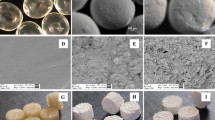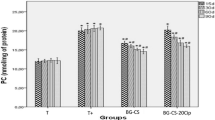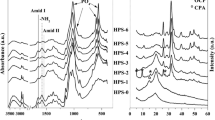Abstract
Polyhydroxybutyrate/chitosan/calcium phosphate composites are interesting biomaterials for utilization in regenerative medicine and they may by applied in reconstruction of deeper subchondral defects. Insufficient informations were found in recent papers about the influence of lysozyme degradation of chitosan in calcium phosphate/chitosan based composites on in vitro cytotoxicity and proliferation activity of osteoblasts. The effect of enzymatic chitosan degradation on osteoblasts proliferation was studied on composite films in which the porosity of origin 3D scaffolds was eliminated and the surface texture was modified. The significantly enhanced proliferation activity with faster population growth of osteoblasts were found on enzymatically degraded biopolymer composite films with α-tricalcium phosphate and nanohydroxyapatite. No cytotoxicity of composite films prepared from lysozyme degraded scaffolds containing a large fraction of low molecular weight chitosans (LMWC), was revealed after 10 days of cultivation. Contrary to above in the higher cytotoxicity origin untreated nanohydroxyapatite films and porous composite scaffolds. The results showed that the synergistic effect of surface distribution, morphology of nanohydroxyapatite particles, microtopography and the presence of LMWC due to chitosan degradation in composite films were responsible for compensation of the cytotoxicity of nanohydroxyapatite composite films or porous composite scaffolds.








Similar content being viewed by others
References
Muzzarelli R, Baldassarre V, Conti F, Ferrara P, Biagini G, Gazzanelli G, Vasi V. Biological activity of chitosan. Ultrastructural study. Biomaterials. 1988;9(3):247–52.
Thein-Han WW, Misra RDK. Biomimetic chitosan–nanohydroxyapatite composite scaffolds for bone tissue engineering. Acta Biomater. 2009;5:1182–97.
Kong L, Gao Y, Lu G, Gong Y, Zhao N, Zhang X. A study on the bioactivity of chitosan/nano-hydroxyapatite composite scaffolds for bone tissue engineering. Eur Polym J. 2006;42:3171–79.
Siddiqui N, Pramanik K, Jabbari E. Osteogenic differentiation of human mesenchymal stem cells in freeze-gelled chitosan/nano β-tricalcium phosphate porous scaffolds crosslinked with genipin. Mater Sci Eng C. 2015;54:76–83.
Seda Tıglı R, Karakecili A, Gümüsderelioglu M. In vitro characterization of chitosan scaffolds: influence of composition and deacetylation degree. J Mater Sci Mater Med. 2007;18:1665–74.
Hesaraki S, Nezafati N. In vitro biocompatibility of chitosan/hyaluronic acid-containing calcium phosphate bone cements. Bioprocess Biosyst Eng. 2014;37:1507–16.
Hockin XuHK, Simon CG. Fast setting calcium phosphate–chitosan scaffold:mechanical properties and biocompatibility. Biomaterials. 2005;26:1337–48.
Lee JS, Baek SD, Venkatesan J, Bhatnagar I, Chang HK, Kim HT, Kim SK. In vivo study of chitosan-natural nano hydroxyapatite scaffolds for bone tissue regeneration. Int J Biol Macromol. 2014;67:360–66.
Wu W, Hua X, He Z, Wang X, Yu X, Ren W. The bactericidal and biocompatible characteristics of reinforced calcium phosphate cements. Biomed Mater. 2012;7:045003. doi:10.1088/1748-6041/7/4/045003. (10pp)
Mellegård H, Strand SP, Christensen BE, Granum PE, Hardy SP. Antibacterial activity of chemically defined chitosans: Influence of molecular weight, degree of acetylation and test organism. Int J Food Microbiol. 2011;148:48–54.
Hou JW, Qian L, Kou JM, Zhang CW, Jia XJ, Tian W. Effect of water-soluble chitosan on the osteoblast function in MC3T3-E1 cells. Int J Biol Macromol. 2015;72:1041–43.
Jack KS, Velayudhan S, Luckman P, Trau M, Grøndahl L, Cooper-White J. The fabrication and characterization of biodegradable HA/PHBV nanoparticle-polymer composite scaffolds. Acta Biomater. 2009;5(7):2657–67.
Tai HY, Fu E, Cheng LP, Don TM. Fabrication of asymmetric membranes from polyhydroxybutyrate and biphasic calcium phosphate/chitosan for guided bone regeneration. J Polym Res. 2014;21:421. doi:10.1007/s10965-014-0421-8
Sadat-Shojai M, Khorasani MT, Jamshidi A, Irani S. Nano-hydroxyapatite reinforced polyhydroxybutyrate composites: A comprehensive study on the structural and in vitro biological properties. Mater Sci Eng C. 2013;33:2776–87.
Cool SM, Kenny B, Wu A, Nurcombe V, Trau M, Cassady AI, Grøndahl L. Poly(3-hydroxybutyrate-co-3-hydroxyvalerate) composite biomaterials for bone tissue regeneration: In vitro performance assessed by osteoblast proliferation, osteoclast adhesion and resorption, and macrophage proinflammatory response. J Biomed Mater Res. 2007;82A:599–610.
Zheng Y, Wang Y, Yang H, Chen X, Chen Z. Characteristic comparison of bioactive scaffolds based on polyhydroxyalkoanate/bioceramic hybrids. J Biomed Mater Res Part B Appl Biomater. 2007;80B:236–43.
Cheung MK, Wan KPY, Yu PH. Miscibility and morphology of chiral semicrystalline poly-(R)-(3-hydroxybutyrate)/chitosan and poly-(R)-(3-hydroxybutyrateco-3-hydroxyvalerate)/chitosan blends studied with DSC, 1H T1 and T1q CRAMPS. J Appl Polym Sci. 2002;86:1253–58.
Ikejima T, Inoue Y. Crystallization behavior and environmental biodegradability of the blend films of poly(3- hydroxybutyric acid) with chitin and chitosan. Carbohydr Polym. 2000;41:351–56.
Veleirinho B, Coelho DS, Dias PF, Maraschin M, Ribeiro-do-Valle RM, Lopes-da-Silva JA. Nanofibrous poly(3-hydroxybutyrate-co-3-hydroxyvalerate)/chitosan scaffolds for skin regeneration. Int J Biol Macromol. 2012;51:343–50.
Ma G, Yang D, Wang K, Han J, Ding S, Song G, Nie J. Organic-soluble chitosan/polyhydroxybutyrate ultrafine fibers as skin regeneration prepared by electrospinning. J Appl Polym Sci. 2010;118:3619–24.
Ni Y, Huang Ch, Kokot S. A kinetic spectrophotometric method for the determination of ternary mixtures of reducing sugars with the aid of artificial neural networks and multivariate calibration. Anal Chim Acta. 2003;480:53–65.
Skrbic Z, Divjakovic V. Temperature influence on changes of parameters of the unit cell of biopolymer PHB. Polymer. 1996;37(3):505–07.
Medvecky L, Giretova M, Stulajterova R. Properties and in vitro characterization of polyhydroxybutyrate–chitosan scaffolds prepared by modified precipitation method. J Mater Sci Mater Med. 2014; 25(3):777–89.
Padermshoke A, Katsumoto Y, Sato H, Ekgasit S, Noda I, Ozaki Y. Melting behavior of poly(3-hydroxybutyrate) investigated by two-dimensional infrared correlation spectroscopy. Spectrochim Acta Part A. 2005;61:541–50.
Ibrahim M, Osman O, Mahmoud AA. Spectroscopic analyses of cellulose and chitosan:FTIR and modeling approach. J Comput Theor Nanosci. 2011;8:117–23.
Kumirska J, Czerwicka M, Kaczyński Z, Bychowska A, Brzozowski K, Thöming J, Stepnowski P. Application of spectroscopic methods for structural analysis of chitin and chitosan. Mar Drugs. 2012;8:1567–636. doi:10.3390/md8051567
Nah JW, Jang MK. Spectroscopic characterization and preparation of low molecular, water-soluble chitosan with free-amine group by novel method. J Polym Sci Part A. 2002;40:3796–803.
Thamaraiselvi TV, Prabakaran K, Rajeswari S. Synthesis of hydroxyapatite thatmimic bone mineralogy. Trends biomater. Artif Organs. 2006;19(2):81–3.
Slosarczyk A, Paszkiewicz Z. Paluszkiewizc C. FTIR and XRD evaluation of carbonated hydroxyapatite powders synthesized by wet methods. J Mol Struct. 2005;744–747:657–61.
Tachaboonyakiat W, Netswasdi N, Srakaew V, Opaprakasit M. Elimination of inter- and intramolecular crosslinks of phosphorylated chitosan by sodium salt formation. Polym J. 2010;42:148–56.
Takagi O, Kuramoto N, Ozawa M, Suzuki S. Adsorption/desorption of acidic and basic proteins on needlelike hydroxyapatite filter prepared by slip casting. Ceram Int. 2004;30:139–43.
Chou YF, Huang W, Dunn JC, Miller TA, Wu BM. The effect of biomimetic apatite structure on osteoblast viability, proliferation, and gene expression. Biomaterials. 2005;26:285–95.
Woo KM, Seo J, Zhang R, Ma PX. Suppression of apoptosis by enhanced protein adsorption on polymer / hydroxyapatite composite scaffolds. Biomaterials. 2007;28:2622–30.
Shi Z, Huang X, Cai Y, Tang R, Yang D. Size effect of hydroxyapatite nanoparticles on proliferation and apoptosis of osteoblast-like cells. Acta Biomater. 2009;5:338–45.
Kizuki T, Ohgaki M, Katsura M, Nakamura S, Hashimoto S, Toda T, Udagawa S, Yamashita K. Effect of bone-like layer growth from culture medium on adherence of osteoblastlike cells. Biomaterials. 2003;24:941–47.
Yuasa T, Miyamoto Y, Ishikawa K, Takechi M, Momota Y, Tatehara S, Nagayama M. Effects of apatite cements on proliferation and differentiation of human osteoblasts in vitro. Biomaterials. 2004;25:1159–66.
Herten M, Rothamel D, Schwarz F, Friesen K, Koegler G, Becker J. Surface- and nonsurface-dependent in vitro effects of bone substitutes on cell viability. Clin Oral Invest. 2009;13:149–55.
Okada S, Ito H, Nagai A, Komotori J, Imai H. Adhesion of osteoblast-like cells on nanostructured hydroxyapatite. Acta Biomater. 2010;6:591–97.
Himno S, Tsuchida H, Nagao N. N-acetylation in chitosan and the rate of its enzymatic hydrolysis. Biomaterials. 1989;10:574–76.
Pangburn SH, Trescony PV, Heller J. Lysozyme degradation of partially deacetylated chitin, its films and hydrogels. Biomaterials. 1982;3:105–08.
Varum KM, Holme HK, Izume M, Stokke BT, Smidsrod O. Determination of enzymatic hydrolysis specificity of partially N-acetylated chitosans. Biochim Biophys Acta. 1996;1291:5–15.
Davies RC, Neuberger A, Wilson BM. The dependence of lysozyme activity on pH and ionic strength. Biochim Biophys Acta. 1969;178:294–305.
Deligianni DD, Katsala ND, Koutsoukos PG, Missirlis YF. Effect of surface roughness of hydroxyapatite on human bone marrow cell adhesion, proliferation, differentiation and detachment strength. Biomaterials. 2001;22:87–96.
Rizzi SC, Heath DJ, Coombes AGA, Bock N, Textor M, Downes S. Biodegradable polymer/hydroxyapatite composites: Surface analysis and initial attachment of human osteoblasts. J Biomed Mater Res. 2001;55:475–86.
Sadat-Shojai M, Khorasani MT, Jamshidi A, Irani S. Nano-hydroxyapatite reinforced polyhydroxybutyrate composites: A comprehensive study on the structural and in vitro biological properties. Mater Sci Eng C. 2013;33:2776–87.
Wu CS, Hsu YC, Liao HT, Cai YX. Antibacterial activity and in vitro evaluation of the biocompatibility of chitosan-based polysaccharide/polyester membranes. Carbohydr Polym. 2015;134:438–47.
Tanase CE, Sartoris A, Popa MI, Verestiuc L, Unger RE, Kirkpatrick CJ. In vitro evaluation of biomimetic chitosan–calcium phosphate scaffolds with potential application in bone tissue engineering. Biomed Mater. 2013;8:025002. doi:10.1088/1748-6041/8/2/025002
Acknowledgments
This work was supported by the Slovak Grant Agency of the Ministry of Education of the Slovak Republic and the Slovak Academy of Sciences, Project No. 2/0047/14 and within the framework of the project “Advanced implants seeded with stem cells for hard tissues regeneration and reconstruction”, which is supported by the Operational Program “Research and Development” financed through the European Regional Development Fund.
Author information
Authors and Affiliations
Corresponding author
Ethics declarations
Conflict of interest
The authors declare that they have no conflict of interest
Rights and permissions
About this article
Cite this article
Giretova, M., Medvecky, L., Stulajterova, R. et al. Effect of enzymatic degradation of chitosan in polyhydroxybutyrate/chitosan/calcium phosphate composites on in vitro osteoblast response. J Mater Sci: Mater Med 27, 181 (2016). https://doi.org/10.1007/s10856-016-5801-7
Received:
Accepted:
Published:
DOI: https://doi.org/10.1007/s10856-016-5801-7




